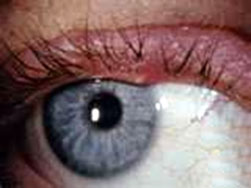|
| |
The Difference Between a Stye and a Chalazion
Styes are caused from swollen eyelid glands, stemming from the base
of an eyelash. It is usually red in appearance and the bump caused by
the stye can be painful to the touch. Styes can occur on either the
upper or lower eyelid. A chalazion can also occur on either the upper or
lower eyelid, but is inside or underneath the eyelid. A chalazion can
occur when a gland in the eyelid becomes clogged and inflamed. |
|
| |
Chalazion
A chalazion (stye) is a small lump in the eyelid caused by obstruction
of an oil producing or meibomian gland. Chalazia may occur in the upper
or lower lids, causing redness, swelling and soreness in some cases.
|
 |
SIGNS AND SYMPTOMS
• Raised, swollen bump on the upper or lower eye lid
• Often red
• May be tender and sore |
DIAGNOSIS
Patients often request an examination after an episode of pain and
swelling of the lid. The doctor can make the diagnosis during a simple
examination of the eyelids
TREATMENT
Sometimes, warm compresses will work to relieve the growths, but a chalazion
may require medical attention. This may include draining
the chalazion along with the use of antibiotic and anti-inflammatory
medications.
|
|
|
|
|
| Both styes and chalazia can come
back, once they have gone away, so it is important to listen to
yours advice! |
|
| |
| |
| Stye |
|
|
|
|
A STYE is the common term used for an acute
infection of a hair follicle or gland at the
edge of the eyelid. The Staphylococcus germ
usually causes it. The correct medical term is
EXTERNAL HORDEOLUM.
These are very common in children, in those with
chronic lid infections such as ocular rosacea,
in diabetics, and sometimes in debilitated
patients with poor hygiene. Styes tend to be
painful, in the early stages when
swelling and redness are prominent. With time,
they often form an abscess and a point on the
skin; more rarely facing inward toward the
eyeball itself. They are not contagious! |
|
 |
TREATMENT consists of
frequent hot packs which usually speed up the
white head formation and pointing to the
surface. Hot packs should be applied to the area
for a minimum of 10 minutes, four times a day.
Hot packs may be purchased, or simply made from
a clean white sock filled with dried beans or
rice. These can be heated in a microwave,
wrapped with a hot, wet facecloth, and applied
to the closed eye for treatments.
Luckily, most chalazion stay small and are just
a minor annoyance and some can be treated at
home with warm compresses and gentle massaging
of the affected area to loosen the plugged oil
gland. Sometimes they resolve on their own
within a few weeks, but when they persist, or
become encapsulated by the body’s defense
mechanism, a steroid injection will help make it
disappear. If the chalazion resists these
treatments, a surgical incision or excision can
be made.
In the worst cases, the
chalazion can be surgically drained and/or
removed in the doctor's office. If the chalazion
returns or if you have had them over a long
period of time, your doctor may send the moved
chalazion to a laboratory to be tested.
Antibiotics may be helpful to decrease the
number of germs present once the gland bursts
and may prevent the spread of infection.
Plucking out the lash from the middle of a stye
will often promote its drainage. Rarely is
surgical drainage or lancing necessary. For
chronic problems, newer therapies include
topical azithromycin, i.e. AzaSite, as well as
oral antibiotics. These may be helpful in
maintaining comfort. Scarring is a very rare
consequence of styes. |
|
|
 |
A common complication with an INTERNAL HORDEOLUM (an
infection of the glands inside the lid), is a secondary PRESEPTAL CELLULITIS, or
inflammation of the soft tissue around the eye.
Cellulitis will not respond to
topical therapy. Oral antibiotics are necessary, with hospitalization needed for
the worst cases.
|
|
|
|
PREVENTION is important! By following careful lid hygiene techniques,
styes may be kept to a minimum. Often the application of a warm washcloth
nightly to the lids followed by lid massage will decrease the infection rate.
Topical lid antibiotic medications like AzaSite may be used concurrently to
create a greater effect. Patients with this condition should know that it
carries a low risk for complications, but that it is important to report any
swelling around the eyelid area to rule out a cellulitis. |
|
|
|
|